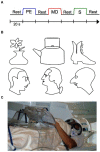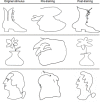Tactile Object Familiarity in the Blind Brain Reveals the Supramodal Perceptual-Mnemonic Nature of the Perirhinal Cortex
- PMID: 27148002
- PMCID: PMC4828456
- DOI: 10.3389/fnhum.2016.00092
Tactile Object Familiarity in the Blind Brain Reveals the Supramodal Perceptual-Mnemonic Nature of the Perirhinal Cortex
Abstract
This study is the first to investigate the neural underpinnings of tactile object familiarity in the blind during both perception and memory. In the sighted, the perirhinal cortex (PRC) has been implicated in the assessment of visual object familiarity-a crucial everyday task-as evidenced by reduced activation when an object becomes familiar. Here, to examine the PRC's role in tactile object familiarity in the absence of vision, we trained blind participants on a unique memory-guided drawing technique and measured brain activity while they perceptually explored raised-line drawings, drew them from tactile memory, and scribbled (control). Functional magnetic resonance imaging (fMRI) before and after a week of training revealed a significant decrease in PRC activation from pre- to post-training (i.e., from unfamiliar to familiar) during perceptual exploration as well as memory-guided drawing, but not scribbling. This familiarity-based reduction is the first evidence that the PRC represents tactile object familiarity in the blind. Furthermore, the finding of this effect during both tactile perception and tactile memory provides the critical link in establishing the PRC as a structure whose representations are supramodal for both perception and memory.
Keywords: blindness; familiarity; perirhinal cortex; tactile memory; tactile perception.
Figures




References
Grants and funding
LinkOut - more resources
Full Text Sources
Other Literature Sources

